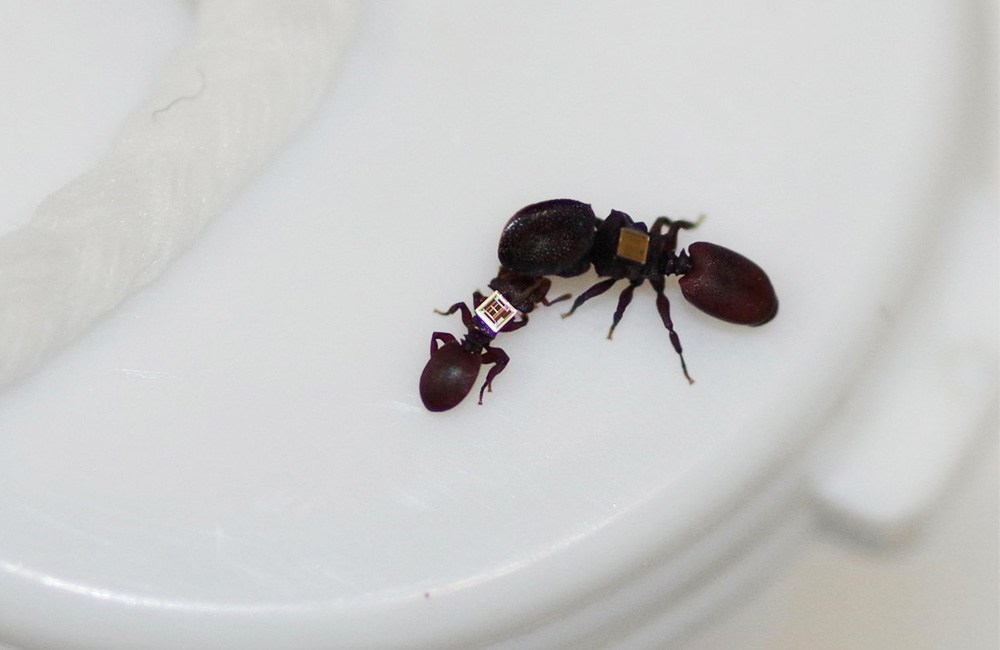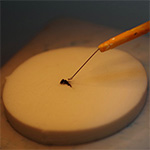NSF Funds Biology Research on Ant Networks
June 27, 2018
It’s a late-spring afternoon at Harvey Mudd College. Biology professor Matina Donaldson-Matasci is setting up a camera and tripod in her biology lab, preparing to document a particularly photogenic aspect of her research on turtle ants: The application of tiny radio frequency identification (RFID) tags to each ant’s thorax.
“I’m excited to learn about how ants work together to solve hard problems,” says Donaldson-Matasci, who, along with collaborators at University of York in England and George Washington University has received National Science Foundation funding for the project, “Dynamic ant networks: How environmental constraints and ecological context shape resource transport systems.”
The project aims to develop a general theory for biological networks that Donaldson-Matasci says “will emphasize how network structure and function dynamically influence one another, and how ecological context shapes this process. Ants are a good system to study transport networks. They carry things around, food and brood, between the various nests. You can think of the nests like subway stations, and the goal is to make a system that is really good at transporting stuff/people between stations, without being too costly to maintain.”
Donaldson-Matasci oversees the laboratory-experiment phase of the research; field work will be done in the Florida Keys (led by collaborator Scott Powell, at George Washington University), where the ants are a native species, and computational modeling will be done at the University of York, led by collaborator Elva Robinson.
 The first step is to tag the ants so that they can be identified individually within their colonies. After anesthetizing a turtle ant with nitrogen gas, Joanna Chang ’18 (POM) gently sandwiches it in a foam disk, stabilizing it with its thorax exposed. Then, with the help of a microscope, she uses a delicate, wire-tipped tool to apply a tiny drop of epoxy to the ant’s thorax. Next, it’s time to affix the RFID tag, which has the size and appearance of a single piece of silver glitter.
The first step is to tag the ants so that they can be identified individually within their colonies. After anesthetizing a turtle ant with nitrogen gas, Joanna Chang ’18 (POM) gently sandwiches it in a foam disk, stabilizing it with its thorax exposed. Then, with the help of a microscope, she uses a delicate, wire-tipped tool to apply a tiny drop of epoxy to the ant’s thorax. Next, it’s time to affix the RFID tag, which has the size and appearance of a single piece of silver glitter.
Tag attached, the sleeping ant is passed to Michelle Lilly ’19, who scans the tag with a laser, activating a circuit on the tag that broadcasts a unique number. The number is automatically added to the colony database.
Once the ants are tagged (and awake), the researchers will place them into specially made arenas where they can choose between nests that are connected to one another in different ways. At that point, Donaldson-Matasci and her students can begin to observe the ants’ behavior and try to figure out why they do what they do.
“The main idea is really about learning how ants build their highly efficient and flexible transportation systems in a very different way from how human engineers do it, in this distributed way where every ant is contributing her own limited knowledge and experience,” she says.
Over the course of the four-year project, there will be opportunities for Harvey Mudd students to do field work in Florida as well as computational modeling in England. For now, they are enjoying their time in the lab. The ants, now adorned with their RFIDs, sparkle in the lab light as they climb around in their clear plastic habitats, exploring cardboard bridges and rolled paper twigs. Asked if she explains in detail her ant-tagging activities to friends and family who might ask about her summer research, Chang laughs. “I mostly just tell them I work with ants.”
For more details on the project and to see more photos, follow Donaldson-Matasci on Twitter (@MatinaDonaldson) and read updates on the HMC Bee Lab Blog.
NSF grants are the largest share of external support for faculty research at Harvey Mudd College.
